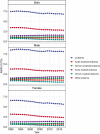Leukemia incidence trends at the global, regional, and national level between 1990 and 2017
- PMID: 32577323
- PMCID: PMC7304189
- DOI: 10.1186/s40164-020-00170-6
Leukemia incidence trends at the global, regional, and national level between 1990 and 2017
Abstract
Background: Leukemias are a group of life-threatening malignant disorders of the blood and bone marrow. The incidence of leukemia varies by pathological types and among different populations.
Methods: We retrieved the incidence data for leukemia by sex, age, location, calendar year, and type from the Global Burden of Disease online database. The estimated average percentage change (EAPC) was used to quantify the trends of the age-standardized incidence rate (ASIR) of leukemia from 1990 to 2017.
Results: Globally, while the number of newly diagnosed leukemia cases increased from 354.5 thousand in 1990 to 518.5 thousand in 2017, the ASIR decreased by 0.43% per year. The number of acute lymphoblastic leukemia (ALL) cases worldwide increased from 49.1 thousand in 1990 to 64.2 thousand in 2017, whereas the ASIR experienced a decrease (EAPC = - 0.08, 95% CI - 0.15, - 0.02). Between 1990 and 2017, there were 55, 29, and 111 countries or territories that experienced a significant increase, remained stable, and experienced a significant decrease in ASIR of ALL, respectively. The case of chronic lymphocytic leukemia (CLL) has increased more than twice between 1990 and 2017. The ASIR of CLL increased by 0.46% per year from 1990 to 2017. More than 85% of all countries saw an increase in ASIR of CLL. In 1990, acute myeloid leukemia (AML) accounted for 18.0% of the total leukemia cases worldwide. This proportion increased to 23.1% in 2017. The ASIR of AML increased from 1.35/100,000 to 1.54/100,000, with an EAPC of 0.56 (95% CI 0.49, 0.62). A total of 127 countries or territories experienced a significant increase in the ASIR of AML. The number of chronic myeloid leukemia (CML) cases increased from 31.8 thousand in 1990 to 34.2 thousand in 2017. The ASIR of CML decreased from 0.75/100,000 to 0.43/100,000. A total of 141 countries or territories saw a decrease in ASIR of CML.
Conclusions: A significant decrease in leukemia incidence was observed between 1990 and 2017. However, in the same period, the incidence rates of AML and CLL significantly increased in most countries, suggesting that both types of leukemia might become a major global public health concern.
Keywords: ALL; AML; CLL; CML; Global; Incidence; Leukemia.
© The Author(s) 2020.
Conflict of interest statement
Competing interestsThe authors declare that they have no competing interests.
Figures





References
LinkOut - more resources
Full Text Sources

